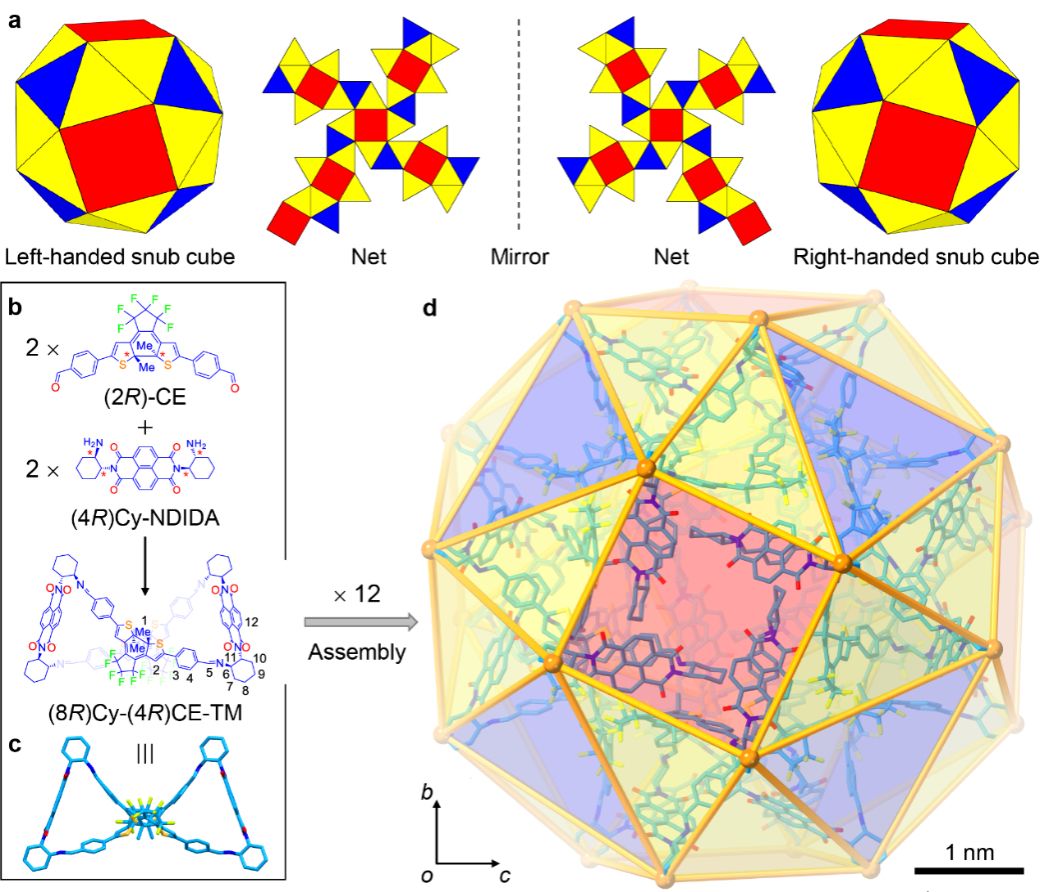New Nature Publication Shed Lights on Constructing Dynamic Snub Cubes
A team of researchers led by Professors Wenping Hu, Yu Wang, and Huang Wu from the School of Science, in collaboration with Nobel Laureate Professor J. Fraser Stoddart, has achieved a major breakthrough in the construction of dynamic supramolecular snub cubes (SSCs). Their findings, published in the prestigious journal Nature under the title of Dynamic Supramolecular Snub Cubes, represent a significant advancement in supramolecular chemistry and biomimetic materials science ( (Nature 2025, DOI:10.1038/s41586-024-08266-3). Professors Wenping Hu, J. Fraser Stoddart, Yu Wang, and Huang Wu are listed as corresponding authors, with Professor Huang Wu as the first author.

The study tackles a long-standing challenge in supramolecular chemistry: stereospecific assembly of artificial polyhedra with mechanical properties and guest-binding attributes akin to biological encapsulants such as viral capsids and ferritin. The snub cube, one of the 13 Archimedean solids described by the ancient Greek mathematician Archimedes over 2,000 years ago, has fascinated scientists due to its intrinsic topological chirality and structural complexity. However, achieving the stereospecific assembly of such a polyhedron has been a formidable challenge—until now.
The research team leverages hierarchical chirality transfer protocol to the stereospecific assembly of enantiomeric supramolecular snub cubes. These snub cubes were constructed from 12 helical macrocycles, which were stabilized by 144 weak C–H hydrogen bonds. The snub cubes exhibit remarkable complexity and precision in structure, featuring 24 vertices, 60 edges, and 38 faces, including six squares, eight equilateral triangles, and 24 scalene triangles. Each snub cube contains 2,712 atoms and has an external diameter of 5.1 nanometers. The cube has a giant chiral cavity with a volume of 6,215 ų and a radius of 2.3 nanometers.
One of the striking features of these supramolecular snub cubes is their stimulus responsiveness and dynamic reversibility. The cubes exhibit reversible photochromic behavior, i.e., changing their color under different wavelengths of light, and manageable mechanical properties, including photocontrollable elasticity and hardness. These observations make the snub cubes not only a feat of structural design but also promising candidates for developing smart materials and advanced optoelectronic devices.
In addition to their dynamic properties, the snub cubes demonstrate exceptional host-guest complexation capabilities. Their unique porous superstructures allow them for the simultaneous encapsulation of multiple guest molecules, as well as the selective binding of two different guests within their internal cavities and external surfaces pockets. This property mimics the multicomponent binding behavior of viral capsids, offering a valuable pathway to understanding the sophisticated function of spherical biological encapsulants.
The implications of this research extend far beyond chemistry. By mimicking the superstructures and properties of biological systems, the study organically bridges supramolecular assembly with biomimicry. The investigation provides a fresh pathway for constructing chiral polyhedra, crystalline materials with photocontrollable mechanical properties, and multicomponent encapsulation artificial containers. Moreover, the chiral porous superstructure of the snub cubes could have applications in fields ranging from chiral separation to drug delivery.
Professor Wenping Hu remarked on the broader significance of the study, stating, “Science is about exploring the unknown. Archimedean polyhedra have captivated mathematicians, chemists, and materials scientists for centuries. This type of fundamental research has the potential to drive innovation across a range of disciplines, from new materials to biomedicine and chemical engineering.”
The study not only opens new doors for designing and synthesizing of chiral artificial polyhedra, but also lays the foundation for future breakthroughs in the development of intelligence photoelectric materials.
By Eva Yin

